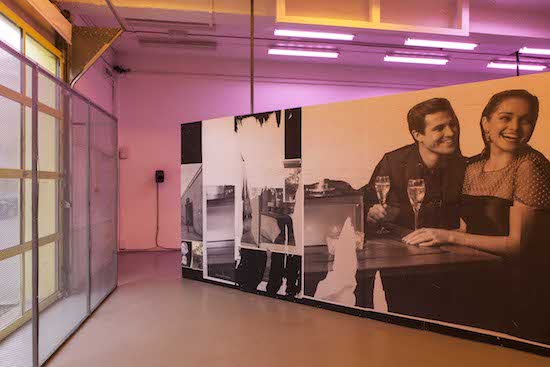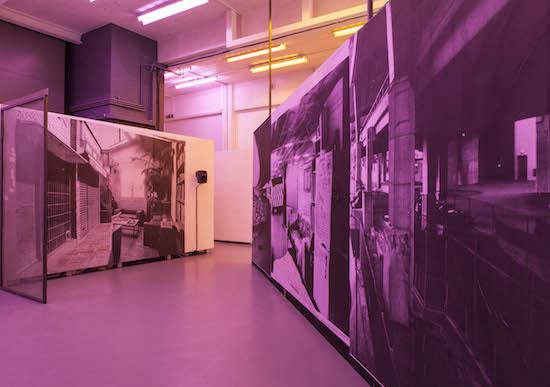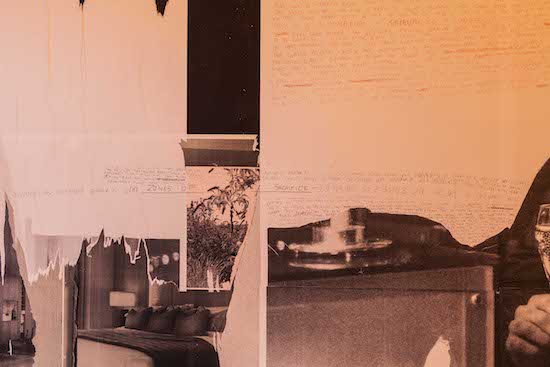“This is where this new West End Gate development is going. This thing is going to completely tower over everything. See the Hilton next to Marylebone Flyover?”
Yes, I reply.
“It’s going to be twice as big as that.”
We’ve just turned off Church Street into the heavy traffic of Edgware Road. Across the road from the carpet shops and the hair salons, the west side of the road is all boarded up with developer’s hoardings, marking the border of the new “landmark residential tower and surrounding mansion blocks”, recently approved for construction and launched with much fanfare onto the property market at the start of the year.
It is the visible sign of a more discrete process of social cleansing, as local residents are gradually being forced out of the area – towards Ilford, Barking, or Coventry – to make way for the new inhabitants expected to tower over the markets and Peabody estates from their thirtieth floor suites embodying, as the marketing bumf goes, “the quintessential London lifestyle.”
The work of Laura Oldfield Ford, from her long-running zine Savage Messiah to her latest exhibition at The Showroom, just a few blocks from where we are walking, alerts its audience to the existence of another London, just as “quintessential”, if not more so. A London in which dreams of freedom forever rub up against the agents of its suppression, of squat parties and surveillance, rioting youth and anaemic yuppiedromes.
“Shall we go for a drift, then?” Oldfield Ford had said, as we finished our mugs of tea in the upstairs room of the gallery. “One of the basic situationist practices,” Guy Debord had written in December 1958’s second issue of Internationale Situationniste, “is the dérive [‘drift’], a technique of rapid passage through varied ambiences.” For Debord, the drift was “quite different from the classic notions of journey or stroll”. It involved allowing oneself to “be drawn by the attractions of the terrain and the encounters they find there.” For Ivan Chtcheglov, the dérive was to the totality of the urban landscape what psychoanalysis is to language.

Bracing ourselves against the January winds, we set off in search of psychogeographical pivot points, down Edgware Road and under the Marylebone Flyover, through the quiet crescents and squares north of St. George’s Fields and back up through Paddington Basin, east along the Westway and north once more, rejoining the fruit sellers and antique shops of Church Street Market, around the fringes of the once-notorious Lisson Green Estate and finally back to The Showroom, where we started off.
We walked half-purposively, half at random, following signs laid out for us by the city, vaguely pursuing a trajectory mapped out by Oldfield Ford in a series of walks conducted last summer whose fruits – in images, recorded sounds, spoken and written texts – had formed the basis of her present installation. She led, I followed.
“Do you know where you are yet?” she would ask me from time to time.
I think so, I would answer uncertainly.
So how far back does your connection with this area go?
I started working round here about 2002, 2003. I was working for Westminster Council. Doing community outreach, mainly with homeless people and old people in day centres around here. No-one else really wanted to do the homeless hostels and the day centres, but I really loved it. Partly because it gave me that incredible insight into London. I probably did that job for about the best part of ten years. So I got to know a lot of people and became really good friends with a lot of people. Really old people. I would go round to their houses and help them with their shopping and watch television with them.
So tell me about ‘drifting’ as a method. I mean, obviously it goes back to the Situationists, but…
I’ve always said that I really want to reinvigorate it. It seems to have been softened and neutralised in the 90s, the term psychogeography. I wanted to restore some of that radical critique, that polemic that I felt was missing. It had become this middle-class observation, walking around London observing – or, even worse, a sort of colonialism: discovering somewhere.
Like a sort of tourism
Whereas, for me, it was much more about a sort of channeling, tuning in to these currents, these dormant threads, in order to reactivate moments of intensity. This is something I used to talk to Mark [Fisher] a lot about, and I guess it shares some of the same concerns with ‘hauntology’, as he talked about it. For me it was much more about tuning into collective moments of euphoria, like Reclaim the Streets, parties taking over the Westway, blocking roads, these collective moments of euphoria, breaking out of this atomised despondency and actually achieving something really empowering. Or moments of militancy and moments of collective trauma as well. I often talk about IRA bombings.
Or the blitz
Yeah, absolutely. So I always talk about tuning into these psychic contours, and walking as a way of gauging those affective shifts. I’m always talking about getting off social media and walking around precisely for that reason, because you break out of that echo chamber. You can gauge the mood of what’s happening. This summer, I wasn’t just walking around this area – I was travelling all around the country. It was quite clear to me which way Brexit was going to go. But people I knew that were just on Facebook all the time or hanging around at private views were really stunned by it.
I was stunned by it
I guess this is what I mean. That’s the purpose it serves for me. It’s not just psychogeography in the sense of talking about a subjective engagement with a place. It’s much more to do with tuning into these affective shifts. Working in those old people’s homes was like that. You’d go out shopping with people, go on a little walk, and you’d get a real sense. Walking unlocks memory.

[After a while we turn out onto the main road, by Paddington Station. Shops selling Union Jack holdalls and royal commemorative plates]
I find these tourist areas really bizarre, as well. There’s a sense of time standing still. All these shops sell exactly the same stuff, year in, year out. There’s no sense of fashion. Everything’s just frozen in time.
Every now and then a new element will be added – like the emoji pillows
And Minions! I’m obsessed with Minions.
What is it about Minions?
I don’t know. I just think that they’ve become such a ubiquitous thing and they’re so sinister. They seem to represent something. I’m always thinking about this collective malaise. But also a kind of individualised psychoactive experience as well. Everyone’s on anti-depressants and everyone’s drinking massive glasses of white wine in Wetherspoons and everyone’s smoking weed on building sites. But it’s not about a kind of collective euphoria, a coming together. It’s much more individualised.
Like a kind of self-medication
Yeah, it’s like managing stress.
I think the way we use music is becoming more like that as well. People use iPods to regulate their moods
Exactly. Yeah. What I’m interested in mapping are those ruptures, those breaks where the walls come down and that seizing of collective power can happen again. In a way, that’s why I’m obsessed with the 2011 riots. Also, last year, when we had that spell of hot weather, there were a few little moments., in Hyde Park and in Stamford Hill.
[Round the back of Paddington Station, we pass what Oldfield Ford lovingly calls “the weirdness of St. Mary’s Hospital”, and find a path out to the canal side where a series of new glass-fronted buildings loom over the still waters]
…And then you go through here and you can cut through to Paddington Basin. They’re trying to make Paddington Basin like Canary Wharf or something. I used to go to a lot of parties under the Westway and I’d been involved in that squat scene. Elgin Avenue and Bramley Arms. That was a bit before my time. But I did catch the tail-end of that, so I did go to a few parties around the Westway in the early nineties. Acid house parties. There was a big party that was almost in the foundations of the Westway. It was called the Family Home. Test Dept. played there. It was one of those sort of places. I went back there about ten years ago to try and find it, and you could just see that they were redeveloping this Paddington Basin area and they had ripped out and exposed the foundations again of the Westway stanchions and you could see the pink emulsion and checkerboard formations of the old dancefloor.
What other kind of changes did you notice, walking around here recently, compared to when you were here before?
Well, round Church Street, it felt exactly the same. That was what was sort of shocking about being there again. It’s still maintained that same character. Because the reason I like it is not because of any conservative or boring ideas about community, but the fact that anyone can belong to it. It’s got a sort of working class identity, but it’s still about transience. It’s still about belonging everywhere and nowhere. Being able to move through these spaces. That’s what I thought was being restricted and what’s been lost, really. So I was really happy it was still the same. But then, this bit, Paddington Basin – it’s just the increased surveillance and the way all that freedom that we used to have is being curtailed. I mean, can you imagine the idea of having an underground, unregulated squat in the basement of that motorway, now?

[Having turned back on to the Harrow Road, under the shadow of the Westway, we come to a gap in more developer’s hoardings hiding further new-builds-in-progress around Paddington Basin, where we peek in at the vast building site being churned up by earth-moving machines]
Bloody hell! This has accelerated so much since this summer. It’s like Aldgate near where I live. It’s just exactly the same. I’ve got this theory about Zones of Sacrifice, Heritage Zones, Zones of Refuge. The idea that, when you’ve got all this wealth, they also need to house people that are going to work in the service sector or in hospitals or whatever. I think this is what this new infrastructure is about: Crossrail and HS2. They know they still need the proles. So they were prepared to sacrifice areas like Church Street, to put all the proles in one places. But now they’re not even prepared to do that. They want the proles living in Ilford, having to get Crossrail into work every day. I really think that’s what these big projects are all about.
[The cold, grey edifice of Paddington Green Police Station looms over us from across the road]
Don’t you think Paddington Green Nick is one of the most sinister buildings in London?
Yes
It’s got loads of floors underground, where they held the terror suspects. That’s the place.
It looks almost like – I remember going to Riga a few years ago, and the former KGB headquarters in Riga – it’s been turned into a museum now – but, from the outside, it’s a very similar looking building
Well that says it all. That just sums it up.
[Back through the underpass at the crossroads by Edgware Road Station, our footsteps echo on the concrete]
The police station is getting closed down as well, apparently. It makes the whole area feel really vexed. But I think this crossroads was a really significant setting. Edgware Road was Watling Street, I think. The Roman Road. So that would have always been a significant dividing line, a significant border. But I’ve always been really interested in crossroads anyway, because they’re liminal zones, threshold sites. Crossroads always have that feeling anyway. Crossroads used to be where outlaws used to be buried and things.
And all those myths about meeting the devil… One of the interesting things about your work is you’re able to take a name like Isis or Eden, just a name bestowed on a tower block, but you can re-activate the mythic potential behind that name
Yeah, well those names just loomed up like talismans or something. Because I went into the site office with the regeneration plan and looked at it. The names were just looming up from the plan. I did think about Isis. That whole myth of her piecing the fragments of her dead husband back together, resurrecting him. So in a sense, it’s like a shamanic thing, isn’t it? Piecing these fragments together. And I’ve been thinking a lot about that in relation to memory. What I was saying before about reactivating these currents. It is about reassembling fragments, or revisiting these certain moments of intensity in order to follow these other trajectories and lost futures. Sifting through those fragments is an important part of that. Eden, as well. You know Mark [Fisher] always used to go on about that story by H.G. Wells, ‘The Door in the Wall’.
Oh yeah… About a green door on an ordinary urban street that leads to this sort of secret garden, some magical other world. It was central to Mark’s notion of the ‘weird’
It was set around the area we’ve just been walking around. That has a strong resonance with my work. The idea of mundane streets, dealing with the mundane reality of getting by, living in precarious situations – but then you get this glimpse of an alternative reality. The sense of the proximity to that other realm that’s really close – but only at certain times. There’s a moment of rupture, or a sort of tear, that you can have a glimpse of it. So when I saw Eden House, of course, it just seemed perfect to talk about that.

[We trudge up Lisson Street, past long-covered-over traces of wartime bomb damage, sites once occupied by railway goods yards, through Broadley Street Gardens, swarms of seagulls overhead, and back up to Church Street]
Can you smell that smell?
Yes, what is it?
It’s coming from that shisha place over there. But to me, it smells like wood smoke or vetiver. It’s a recurring thing that I talk about in the work as well, that recurring smell. Because I find it so evocative. It reminds me of the traveller scene and free party scene. Bonfires in barrels in the middle of industrial estates with massive sound systems. I love it when I smell that. At the end of this street is the Lisson Green Estate. Did you notice in the audio track, that news report from the riots, where they talk about kids coming out of the estate and robbing gold watches off people? I recorded that off Channel Four News.
So you recorded that five and a half years ago, in 2011, and you just had it, hanging around, waiting for somewhere to put it?
Yeah, exactly, yeah. Yeah, I’ve got such a vast archive of things. But it’s not ordered. In a way, that moment that I recorded from the news, after the riots, it was just another one of those moments when the walls came down. The walls just seemed to melt.
But again, that’s one of the interesting things about London, that there are these very different class communities very close to each other – unlike, say, Paris where everyone is shoved out to the banlieue.
Yeah. I think that’s what I’ve always loved about London, in a way, the inner city. There’s been this inversion recently. There does seem to be a drive now to make it more like the Parisian model, pushing people right out to the periphery. It’s got to the point now where I think, apart from odd little pockets like here, that remain, you have to go out, now, to zones four, five, and six to get a sense of that intensity that you used to get in the inner cities. Places like Hounslow and Croydon and Edmonton, a lot of places did kick off. That seems to be where you get more of those collisions of ideologies and beliefs. Central London just seems to be flattening out. I still think there’ll be a moment when we’ll be able to get back in though, when all these yuppiedromes are negative equity ghettoes.
I hope so
Laura Oldfield Ford, Alpha/Isis/Eden, is at The Showroom, London, until 18 March


